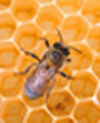
To honeybee or not to honeybee, that is the question?
An investigation of interdependence and survival in the Himalayas and U.S.A.
Created by Ben Zimmerman
McAuliffe Regional Charter Public School
Framingham, MA
| MISSION COMMAND |
| MISSION TWO: Religions |
| MISSION THREE: Honeybees |
| MISSION FOUR: Economic and Social Implications |
| MISSION FIVE: Culminating Activities |
| SALUTE |
Mission Command(a.k.a. Homepage)
Purpose
The National Endowment of the Arts Summer Institute 2008 at Holy Cross focused on K-12 teacher scholarship in the Literatures, Religions, and Arts of the Himalayan Region. The expected outcome of the Institute's participants was a curriculum implementation plan via a website. The website adventure you are about to embark on will only scratch the surface of the many possibilities that the “To honeybee or not to honeybee, that is the question?” investigation holds. Please view this site as the sketched on canvas of a masterpiece to come. Although this is a work in progress, let your imagination take you where it wishes. Enjoy!
A Gentle Intro
I teach 6th grade English language arts and social studies (world geography) at McAuliffe Regional Charter Public School (MRCPS) in Framingham, MA. At MRCPS we do product-based experiential learning with the intended outcome of making real and present differences in the local community and/or communities abroad. For more information on our school’s educational foundation please visit Expeditionary Learning School's website.
As is the case with most guiding questions (i.e. To honeybee or not to honeybee…?), there are many answers and many ways to find those answers. Thus, this investigation can serve a breadth of content areas or it can easily be refined to a few. I teach world geography through the five themes of geography. Again, you could teach to all five themes or solely focus on one; time and teaching are, as usual, the determinants.
For my curricular purposes this unit will serve the purpose of social science (6th grade world geography), English language art, and science. You may find the science section of this website particularly scant due to the fact that I do not directly teach that material. The depth of the scientific and ecological honeybee background will be crafted by my fellow team teacher in the science class, with the likely infusion of math as well.
This unit of study is designed to serve as the culminating unit to the 6th grade school year. The year’s curriculum peers into the looking glass of who, what, where, when, why, and how the stuff we as humans possess is created and makes its way to us (particular attention is given to food systems). This final unit of the year is to serve as an inspiration for a call to action. The hope is that by educating the students about an issue that is not only a problem abroad but also in their own “backyards,” that it will enable them to make a clear and present difference in their community. Follow the "Missions" as though they are loose lesson plans leading to the final mission "Culminating Activities."
NEH Institute Implementation
1. Geography-I now have a concrete understanding of human and animal ecology in relation to the region known as the Himalaya.
2. Sustainability-I will use the case study of the Ladakhi people of northern India we learned during the institute as a model for broaching such topics like sustaining culture (subsistence livelihood), over growth (globalism), and human ecology and the sustainment of a species/food systems.
3. Interdependence-I will use this to inform students of the main tenets of Buddhism, particularly the element of interdependence and the important role it plays in the life of a Buddhist in his/her daily life as well as his/her interaction with the environment. Thus, the importance of maintaining honeybees’ colonies for food pollination arises.
4. Visual Media-Teaching about cultures and regions on the other side of earth is, at best, done through imagination and metaphor. In an effort to bring more realism to the far-fetched land of the Himalaya and all other regions outside of the usual bus field-trip-zone, I have found that visual media gives access. During the institute we screened several movies that I plan to utilize for examples of landscape, ritual, social condition, and ecology. Several of the videos are originals and not attainable outside the institute community.
5. Community Forestry-The information gained from wildlife biologist, Professor David Smith and community development and activist Dr. Narayan Kaji Shrestha, I plan to inform my investigation of Raji and Gurung honey hunters’ dependency on forest for their livelihood.